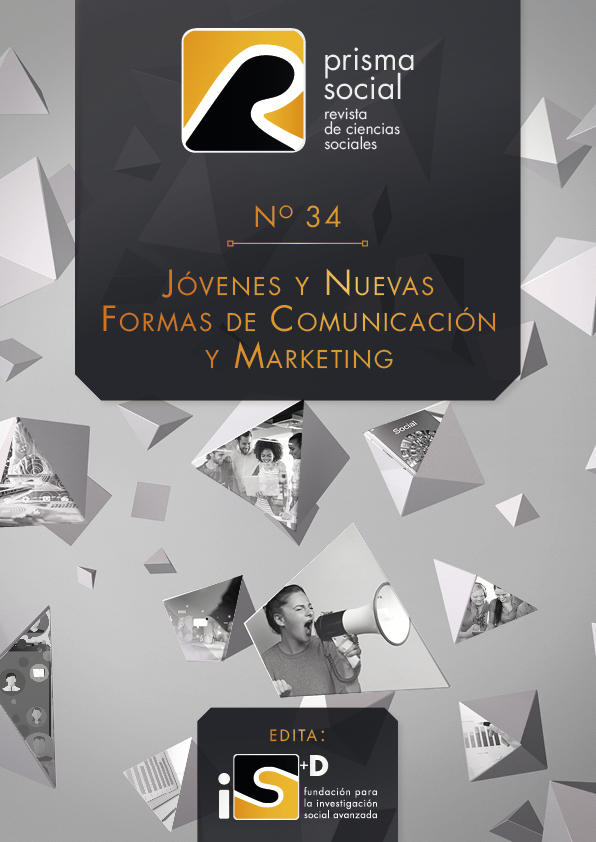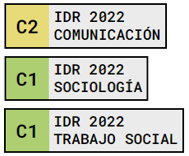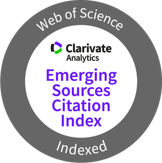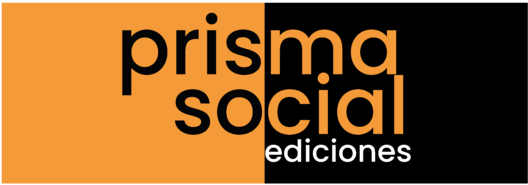Analysis of the type of advertising content incorporated in the channels of teenage youtubers
Keywords:
YouTube, advertising, advertising strategies, teenagers, youtubers, social media, gender, ageAbstract
YouTube is the social network of choice for teenagers and it is where companies have turned their advertising strategies to reach this audience through influencers, who have become new digital celebrities. These new celebrities, known in this social network as youtubers, have an audience that gives their messages greater credibility, compared to those launched by other characters through traditional media. Using content analysis methodology, 300 videos of teenage youtubers, aged between 11 and 17, with more than one million followers, have been studied. The videos were up to 15 minutes long and had more than 1000 views each from Spanish teenage youtubers (11-17 years old), with more than one million followers, from the announcement of state of alarm until its end (year 2020). This investigation goes further into the study of advertising strategies teenagers’ youtubers incorporate in their videos, considering to possible differences in message according to the gender and the age. It concludes that teenage YouTube channels have become commercial showcases with semi-professional performance of minors in which passive product placement is advertising strategies most used by youtubers. In relation to gender, boys are the ones who integrate more content and advertising strategies in their videos and teenagers between 15 and 16 years old are the ones with the highest rates of advertising insertion, above 90%.
Downloads
References
Alonzo González, R. M. (2019). Sobre el uso de los conceptos prosumer y emirec en estudios sobre comunicación. Sphera Publica, 1(19), 2-23. http://sphera.ucam.edu/index.php/sphera-01/article/view/361
Arab, E., & Díaz, A. (2015). Impacto de las redes sociales e internet en la adolescencia: aspectos positivos y negativos. Revista Médica Clínica Las Condes, 26(1), 7-13. https://doi.org/10.1016/j.rmclc.2014.12.001
Ardèvol, E., & Márquez, I. (2017). El youtuber como celebridad mediática: entre la autenticidad y el mercado. Rizoma, 5(2), 72-87. https://doi.org/10.17058/rzm.v5i2.11288
Aziza, D. N., & Astuti, R. D. (2019). Evaluating the Effect of YouTube Advertising towards Young Customers’ Purchase Intention. In 12th International Conference on Business and Management Research (ICBMR 2018) (pp. 93-98). Atlantis Press. https://doi.org/10.2991/icbmr-18.2019.16
Aznar Díaz, I., Trujillo Torres, J. M., Romero Rodríguez, J. M., & Campos Soto, M. N. (2019). Generación Niños Youtubers: análisis de los canales YouTube de los nuevos fenómenos infantiles. Pixel-Bit: Revista de Medios y Educación, 56, 113-128. https://doi.org/10.12795/pixelbit.2019.i56.06
Baños-González, M., & Rodríguez García, T. C. (2012). Imagen de Marca y Product placement. ESIC.
Blanco Ruiz, M., & Sáinz de Baranda, C. (2018). Channels produced by LGBT+ youtubers: gender discourse analysis. Observatorio (OBS*), Special issue on the co-option of audiences in the attention economy, 97-121. https://doi.org/10.15847/obsOBS0001386
Burroughs, B. (2017). YouTube kids: The app economy and mobile parenting. Social media+ society, 3(2). https://doi.org/10.1177/2056305117707189
Caballero Gálvez, A.; Tortajada, I. Y Willem, C. (2017). Autenticidad, marca personal y agencia sexual: el posfeminismo lésbico en YouTube. Investigaciones Feministas, 8(2), 353-368. http://dx.doi.org/10.5209/INFE.55005
Chung-Wha, K., Cuevas, L.M., Chong, S.M., & Lim, H. (2020). Influencer marketing: Social media influencers as human brands attaching to followers and yielding positive marketing results by fulfilling needs. Journal of Retailing and Consumer Services, 55, 102133. https://doi.org/10.1016/j.jretconser.2020.102133
Colás-Bravo, P., González-Ramírez, T., & De-Pablos-Pons, J. (2013). Juventud y redes sociales: Motivaciones y usos preferentes. Comunicar: Revista científica de comunicación y educación, 20(40), 15-23. https://doi.org/10.3916/C40-2013-02-01
Corrêa, S. C. H., Soares, J. L., Christino, J. M. M., de Sevilha Gosling, M., & Gonçalves, C. A. (2020). The influence of youtubers on followers’ use intention. Journal of Research in Interactive Marketing, 14 (2), 173-194. https://doi.org/10.1108/JRIM-09-2019-0154
Cunningham, S., & Craig, D. (2017). Being ‘really real’on YouTube: authenticity, community and brand culture in social media entertainment. Media International Australia, 164(1), 71-81. https://doi.org/10.1177/1329878X17709098
Dantas, T., & Godoy, R. (2016). Youtubers mirins: mera expressão artística ou trabalho infantil?. En: TIC Kids online Brasil 2015. Pesquisa sobre o uso da internet por crianças e adolescentes no Brasil. Comitê Gestor da Internet no Brasil, 95-104. https://bit.ly/3im6wh5
De Veirman, M., Cauberghe, V., & Hudders, L. (2017). Marketing through Instagram influencers: The impact of number of followers and product divergence on brand attitude. International Journal of Advertising, 36(5), 798–828. https://doi.org/10.1080/02650487.2017.1348035
Duffett, R. G., Edu, T., Negricea, I. C., & Zaharia, R. M. (2020). Modelling the effect of YouTube as an advertising medium on converting intention-to-purchase into purchase. Transformations in Business & Economics, 19(1/49), 112-132. https://bit.ly/3aFlYUc
Elorriaga Illera, A., & Monge Benito, S. (2018). La profesionalización de los youtubers: el caso de Verdeliss y las marcas. Revista Latina de Comunicación Social, 73, 37-54. https://doi.org/10.4185/RLCS-2018-1244
Feijoo, B. & Fernández-Gómez, E. (2021). Niños y niñas influyentes en YouTube e Instagram: contenidos y presencia de marcas durante el confinamiento. Cuadernos.info, (49), 300-328. https://doi.org/10.7764/cdi.49.27309
Feijoo-Fernández, B., & García-González, A. (2020). Publicidad y entretenimiento en los soportes online. Youtubers como embajadores de marca a través del estudio de caso de Makiman131. Perspectivas de la Comunicación-ISSN 0718-4867, 13(1), 133-154. https://doi.org/10.4067/S0718-48672020000100133
Fernández-de-Arroyabe-Olaortua, A., Lazkano-Arrillaga, I., & Eguskiza-Sesumaga, L. (2018). Digital natives: Online audiovisual content consumption, creation and dissemination. Comunicar. Media Education Research Journal, 26(2), 61-69. https://doi.org/10.3916/C57-2018-06
Fondo de Población de las Naciones Unidas (FPNU, 2014). Adolescents, youth and the transformation of the future. https://www.unfpa.org/sites/default/files/pub-pdf/EN-SWOP14-Report_FINAL-web.pdf
García Jiménez, A., & Montes Vozmediano, M. (2020). Subject matter of videos for teens on YouTube. International journal of adolescence and youth, 25(1), 63-78. https://doi.org/10.1080/02673843.2019.1590850
Gerhards, C. (2019). Product placement on YouTube: An explorative study on YouTube creators’ experiences with advertisers. Convergence, 25(3), 516-533. https://doi.org/10.1177/1354856517736977
Gómez Nieto, B. (2018). El influencer: herramienta clave en el contexto digital de la publicidad engañosa. Methaodos. Revista de ciencias sociales, 6(1). https://doi.org/10.17502/m.rcs.v6i1.212
Interactive Advertising Bureau (IAB, 2019). Libro Blanco Marketing de Influencers. https://www.amic.me
Islas, O. (2011). La sociedad de la ubicuidad, los prosumidores y un modelo de comunicación para comprender la complejidad de las comunicaciones digitales. Revista Latinoamericana de Ciencias de la Comunicación, (7). Https://bit.ly/336uu1v
Jerslev, A. (2016). In the time of the microcelebrity: Celebrification and the youtuber Zoella. International Journal of Communication, 10, 5233-5251. https://ijoc.org/index.php/ijoc/article/view/5078/1822
Kim, J. (2012). The institutionalization of YouTube: From user-generated content to professionally generated content. Media, Culture & Society, 34(1), 53-67. https://doi.org/10.1177/0163443711427199
Lieb, R., & Szymanski, J. (2017). Content-the atomic particle of marketing: The definitive guide to content marketing strategy. Kogan Page Publishers.
Lobato, R. (2016). The cultural logic of digital intermediaries: YouTube multichannel networks. Convergence: The International Journal of Research into New Media Technologies, 22(4), 348-360. https://doi.org/10.1177/1354856516641628
López-del-Ramo, J. & Montes-Vozmediano, M. (2018). Construcción comunicativa del reportaje infográfico online de calidad. Elementos constitutivos. El profesional de la información, 27(2), 322-330. https://doi.org/10.3145/epi.2018.mar.10
López-Villafranca, P., & Olmedo-Salar, S. (2019). Menores en YouTube ¿ocio o negocio? Análisis de casos en España y EUA. El profesional de la información, 28(5). https://doi.org/10.3145/epi.2019.sep.20
Lowe-Calverley, E., & Grieve, R. (2021). Do the metrics matter? An experimental investigation of Instagram influencer effects on mood and body dissatisfaction. Body Image, 36, 1-4. https://doi.org/10.1016/j.bodyim.2020.10.003
Lune, H., & Berg, B. L. (2017). Qualitative research methods for the social sciences. Pearson Education Limited.
Marôpo, L., Vitorino Sampaio, I. & de Miranda, N. P. (2017). Top Girls on YouTube. Identity, Participation, and Consumption. En: Eleá, I. Y Mikos, L. (Eds.) Young & Creative. Digital Technologies Empowering Children in Everyday Life (pp-221-225). Nordicom. Https://bit.ly/39hpz8u
Martínez Pastor, E. (2019). Menores youtubers en el ecosistema publicitario de los juguetes: límites normativos. Revista Espacios, 40(7), 5-17. http://www.revistaespacios.com/a19v40n07/a19v40n07p05.pdf
Martínez, C., & Olsson, T. (2019). Making sense of youtubers: How Swedish children construct and negotiate the youtuber Misslisibell as a girl celebrity. Journal of Children and Media, 13(1), 36-52. https://doi.org/10.1080/17482798.2018.1517656
Mc Roberts, S., Bonsignore, E., Peyton, T., & Yarosh, S. (2016). Do It for the viewers! Audience engagement behaviors of young youtubers. En: Proceedings of the 15th International Conference on Interaction Design and Children (pp. 334-343). https://doi.org/10.1145/2930674.2930676
Mendivelso, F., & Rodríguez, M. (2018). Prueba Chi-cuadrado de independencia aplicada a tablas 2xn. Revista Médica Sanitas, 21(2), 92-95. https://doi.org/10.26852/01234250.6
Méndiz Noguero, A. (2000). Nuevas formas publicitarias. Patrocinio, “product placement” y publicidad en Internet. Málaga, Universidad de Málaga, Manuales.
Montes, M., Pastor, Y, Martín, R. y Atuesta, J. D. (2020). Smartphone y redes sociales: una aproximación a los usos, vulnerabilidades y riesgos durante la adolescencia en España y Colombia. Revista Espacios, 41(48), 44-59. https://doi.org/10.48082/espacios-a20v41n48p04
Montes-Vozmediano, M., García-Jiménez, A., & Menor-Sendra, J. (2018). Los vídeos de los adolescentes en YouTube: Características y vulnerabilidades digitales. Comunicar, 26(54), 61-69. https://www.doi.org/10.3916/C54-2018-06
Organización Mundial de la Salud (2014). Salud para los adolescentes del mundo. Una segunda oportunidad en la segunda década. Ginebra. http://apps.who.int/adolescent/second-decade/files/WHO_FWC_MCA_14.05_spa.pdf
Pereira, S., Moura, P. & Fillol, J. (2018). The youtubers phenomenon: what makes youtube stars so popular for young people?. Fonseca, Journal of Communication, 17, 107-123. https://doi.org/10.14201/fjc201817107123.
Pérez-Torres, V., Pastor-Ruiz, Y., & Abarrou-Ben-Boubaker, S. (2018). Youtuber videos and the construction of adolescent identity. Comunicar. Media education research journal, 26(1), 61-70. https://doi.org/10.3916/C55-2018-06
Ramos-Serrano, M; Herrero-Diz, P. (2016). Unboxing and brands: youtubers phenomenon through the case study of evantubehd. Revista Prisma Social, 1, 90-120. https://bit.ly/3nludKd
Rego Rey, S., & Romero-Rodríguez, L. M. (2016). Representación discursiva y lenguaje de los' youtubers' españoles: Estudio de caso de los 'gamers' más populares. Index-comunicación, 6(1). https://burjcdigital.urjc.es/handle/10115/15472
Rodríguez Álvarez, V. (2020). Types of product placement: A theoretical overview. In: IROCAMM - International Review of Communication and Marketing Mix, 1(3), (pp.7–22). https://revistascientificas.us.es/index.php/IROCAMM/article/view/11541
Sáez Barneto, G., & Gallardo, J. (2017). La relación de los youtubers con la publicidad y sus espectadores. El caso de YouTube España. Revista TELOS (Cuadernos de Comunicación e Innovación), 107, 1-13.
Sampieri, R. H. (2018). Metodología de la investigación: las rutas cuantitativa, cualitativa y mixta. Mcgraw Hill.
Sánchez-Labella Martín, I. (2020). Youtubers infantiles: los menores como recurso para generar nuevas tendencias publicitarias. Austral Comunicación, 9(2), 249-274. https://doi.org/10.26422/aucom.2020.0902.san
Sánchez-Olmos, C. & Hidalgo-Marí, T. (2016). Del sofá a YouTube: estudio de género sobre la interacción en la red social en torno a las series de TV españolas. Communication & Society 29(2), 117- 132. https://doi.org/10.15581/003.29.2.sp.117-132
Scolari, C. A, Fraticelli, D. (2019). The Case of the top Spanish youtubers: emerging media subjects and discourse practices in the new media ecology. Convergence, 1, 25(3), 496-515. https://doi.org/10.1177/1354856517721807
Souza Araújo, C., Magno, G., Meira, W., Almeida, V., Hartung, P., & Doneda, D. (2017, September). Characterizing videos, audience and advertising in YouTube channels for kids. In International Conference on Social Informatics (pp. 341-359). Springer. Https://link.springer.com/chapter/10.1007/978-3-319-67217-5_21
Suárez-Álvarez, R. S., García-Jiménez, A. (2020). Youtubers adolescentes: diferencias de género y prácticas publicitarias. In La innovación docente, a debate: Aplicaciones en torno a la Comunicación Audiovisual, Publicidad, Relaciones Públicas y Periodismo (pp. 27-36). https://doi.org/10.14198/MEDCOM/2020/15_cmd
Tolbert, A. N., & Drogos, K. L. (2019). Tweens’ wishful identification and parasocial relationships with youtubers. Frontiers in psychology, 10, 2781. https://doi.org/10.3389/fpsyg.2019.02781
Tur-Viñes. V., Núñez-Gómez, P., González-Río, MJ. (2018). Kid influencers on YouTube. A space for responsibility. Revista Latina de Comunicación Social, 73, 1211-1230. https://doi.org/10.4185/RLCS-2018-1303en
UNICEF (2019). Adolescent development and participation. https://www.unicef.org/adolescence
van Dam, S., & van Reijmersdal, E. (2019). Insights in adolescents’ advertising literacy, perceptions and responses regarding sponsored influencer videos and disclosures. Cyberpsychology: Journal of Psychosocial Research on Cyberspace, 13(2). https://doi.org/10.5817/CP2019-2-2
Wotanis, L. & McMillan, L. (2014). Performing Gender on youtube: How Jenna Marbles Negotiates a Hostile Online Environment. Feminist Media Studies, 14:6, 912–928. https://doi.org/10.1080/14680777.2014.882373
Yarosh, S., Bonsignore, E., Mc Roberts, S., & Peyton, T. (2016). Youthtube: Youth video authorship on YouTube and Vine. In Proceedings of the 19th ACM Conference on Computer-Supported Cooperative Work & Social Computing (pp. 1423–1437). https://doi.org/10.1145/2818048.2819961
Zarei, K., Ibosiola, D., Farahbakhsh, R., Gilani, Z., Garimella, K., Crespi, N., & Tyson, G. (2020). Characterising and detecting sponsored influencer posts on Instagram. In 2020 IEEE/ACM International Conference on Advances in Social Networks Analysis and Mining (ASONAM) (pp. 327-331). IEEE. https://arxiv.org/pdf/2011.05757.pdf
Downloads
Published
How to Cite
Issue
Section
License
Copyright (c) 2021 Revista Prisma Social

This work is licensed under a Creative Commons Attribution-NonCommercial-NoDerivatives 4.0 International License.
Those authors who publish in this journal accept the following terms:
-
Authors retain copyright.
-
Authors transfer to the journal the right of first publication. The journal also owns the publishing rights.
-
All published contents are governed by an Attribution-NoDerivatives 4.0 International License.
Access the informative version and legal text of the license. By virtue of this, third parties are allowed to use what is published as long as they mention the authorship of the work and the first publication in this journal. If you transform the material, you may not distribute the modified work. -
Authors may make other independent and additional contractual arrangements for non-exclusive distribution of the version of the article published in this journal (e.g., inclusion in an institutional repository or publication in a book) as long as they clearly indicate that the work was first published in this journal.
- Authors are allowed and recommended to publish their work on the Internet (for example on institutional and personal websites), following the publication of, and referencing the journal, as this could lead to constructive exchanges and a more extensive and quick circulation of published works (see The Effect of Open Access).


















